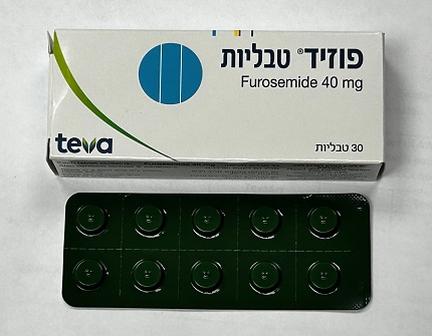Quest for the right Drug

פוזיד טבליות FUSID TABLETS (FUROSEMIDE)
תרופה במרשם
תרופה בסל
נרקוטיקה
ציטוטוקסיקה
צורת מתן:
פומי : PER OS
צורת מינון:
טבליה : TABLETS
עלון לרופא
מינוניםPosology התוויות
Indications תופעות לוואי
Adverse reactions התוויות נגד
Contraindications אינטראקציות
Interactions מינון יתר
Overdose הריון/הנקה
Pregnancy & Lactation אוכלוסיות מיוחדות
Special populations תכונות פרמקולוגיות
Pharmacological properties מידע רוקחי
Pharmaceutical particulars אזהרת שימוש
Special Warning עלון לרופא
Physicians Leaflet
Pharmacological properties : תכונות פרמקולוגיות
Pharmacodynamic Properties
5.1. Pharmacodynamic properties Pharmacotherapeutic group: Diuretics, Diuretics of loop. ATC code: C03CA01 Mechanism of action:Furosemide is a potent, fast-acting diuretic with a rapid onset of action. From the pharmacological point of view, furosemide inhibits co-transport system (reabsorption) of the Na +, K + and – Cl 2 electrolytes, located of the luminal cell membrane of the ascending branch of the Hanley loop consequently, the efficacy of the saluretic action of furosemide depends on the product reaches the tubular lumen through a transport mechanism anionic. Diuretic action results from the inhibition of sodium chloride reabsorption in this segment of the loop of Henle. As a result, the fraction of sodium excreted may to 35% of glomerular sodium filtration. Side effects of excretion increased urinary excretion and increased distal secretion of potassium at the level of the distal tubule. The excretion of calcium and magnesium ions is increased. Furosemide disrupts the tubulo-glomerular feedback mechanism in the macula dense, resulting in non- attenuation of saluretic activity. Furosemide causes dose-dependent stimulation of the renin-angiotensin-aldosterone system. In case of heart failure, furosemide causes an acute reduction in preload (by increasing the capacitance of blood vessels). This vascular effect seems to be mediated by prostaglandins and with the activation of the renin-angiotensin system and an intact synthesis of prostaglandins. Apart from the fact that, given its furosemide decreases the vascular reactivity to catecholamines, which is increased in hypertensive patients. The antihypertensive efficacy of furosemide is attributable to increased excretion of sodium, blood volume reduction and vascular smooth muscle response to the stimulus vasoconstrictor.
Pharmacokinetic Properties
5.2. Pharmacokinetic properties Furosemide is rapidly absorbed from the gastrointestinal tract. The tmax is 1 to 1.5 hours in the case of Furosemide 40 mg. Absorption of the drug denotes a broad intra and interindividual variability. The bioavailability of furosemide in healthy volunteers is approximately 50%-70% for tablets. In the case of sick individuals, the bioavailability of drug is influenced by several factors, including concomitant diseases, can be reduced by around 30% (for example in the case of nephrotic). The fact that the absorption of furosemide may be affected by food intake and effect seems to depend on the pharmaceutical formulation in question. The volume of distribution of furosemide is 0.1 to 1.2 liters per kg of body weight. The plasma protein binding (mostly to albumin) is greater than 98%. Furosemide is mostly eliminated in the non-conjugated form, mainly by secretion at the level of the proximal tubule. Following intravenous administration, 60% to 70% of the furosemide dose is excreted in this way. The glucuronic metabolite of furosemide represents 10% to 20% of the substances recovered in the urine. The remaining dose is excreted in the faeces, probably after biliary secretion. The terminal half-life of furosemide after intravenous administration is approximately 1 to 1.5 hours. Furosemide is excreted in breast milk. Furosemide crosses the barrier the placenta slowly transferring to the fetus. Furosemide reaches concentrations identical in the mother and in the fetus or newborn. Renal insufficiency In case of renal insufficiency, the elimination of furosemide is slower and its half-life is prolonged, the terminal half-life may reach 24 hours in patients with severe renal impairment. In case of nephrotic syndrome, the lower concentration of plasma proteins leads to that higher concentrations of unconjugated (free) furosemide are achieved. Per On the other hand, the efficacy of furosemide is reduced in these patients, due to the intratubular albumin and decreased tubular secretion. Furosemide is poorly dialysable in patients receiving hemodialysis, dialysis peritoneal or CAPD (Chronic Ambulatory Peritoneal Dialysis). Hepatic insufficiency In case of hepatic impairment, the half-life of furosemide in the order of 30% to 90%, mainly due to the higher volume of high. In addition, in this group of patients there is pharmacokinetic parameters. Congestive heart failure, severe hypertension, elderly elimination of furosemide is slowed due to reduced renal function in patients with congestive heart failure, severe hypertension or in the elderly. Premature and new born infant Depending on the maturity of the kidney, elimination of furosemide may be slower. The metabolism of the drug is also reduced in the case of children with insufficiency of glucuronization capacity. The terminal half-life is less than 12 hours in children with a post- conception age greater than 33 weeks. In children with terminal age is equal to that of adults.

שימוש לפי פנקס קופ''ח כללית 1994
Congestive heart failure, acute pulmonary edema, cirrhosis with ascites, hypertension, nephrotic syndrome, hypercalcemia
תאריך הכללה מקורי בסל
01/01/1995
הגבלות
תרופה שאושרה לשימוש כללי בקופ'ח
מידע נוסף
